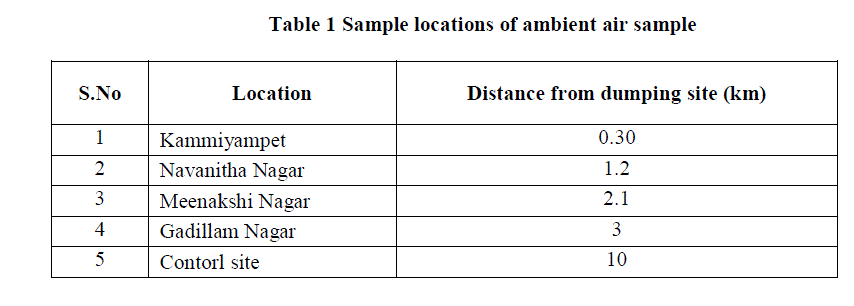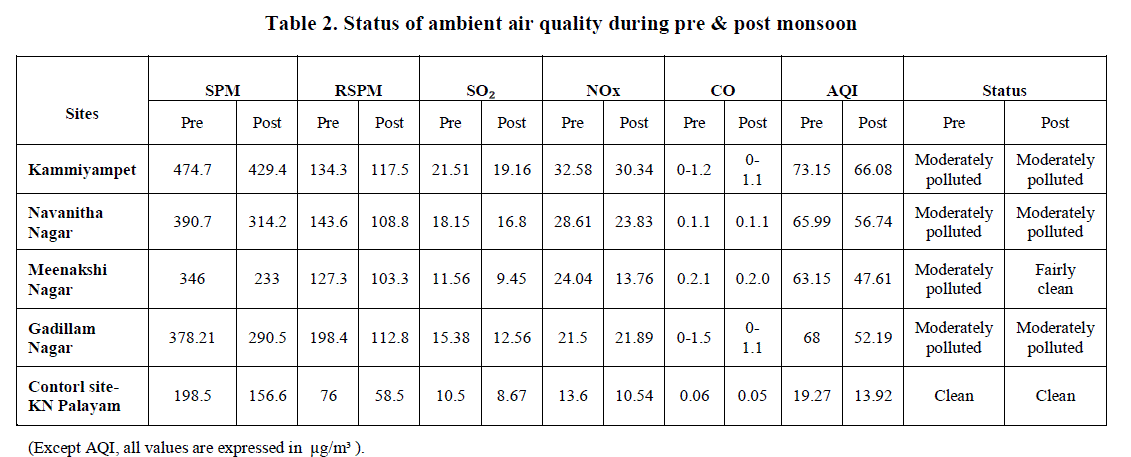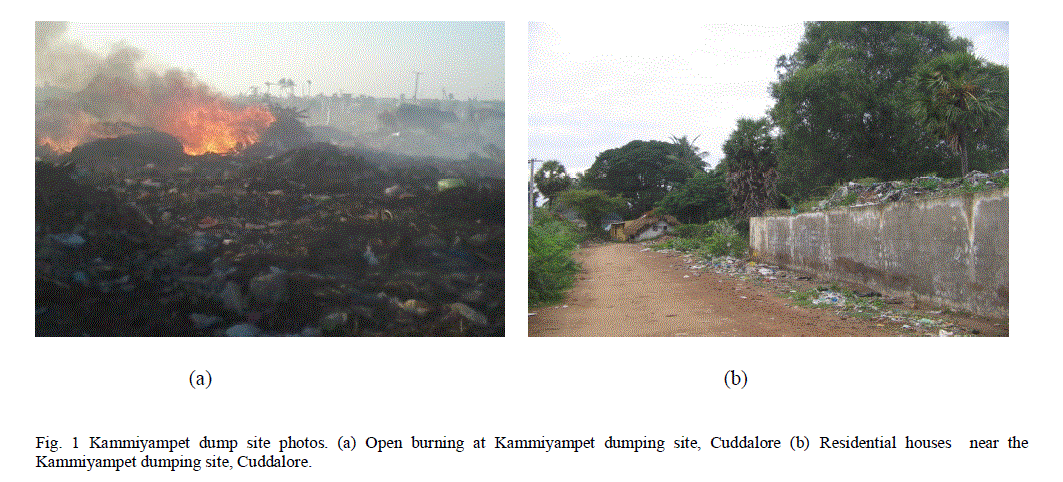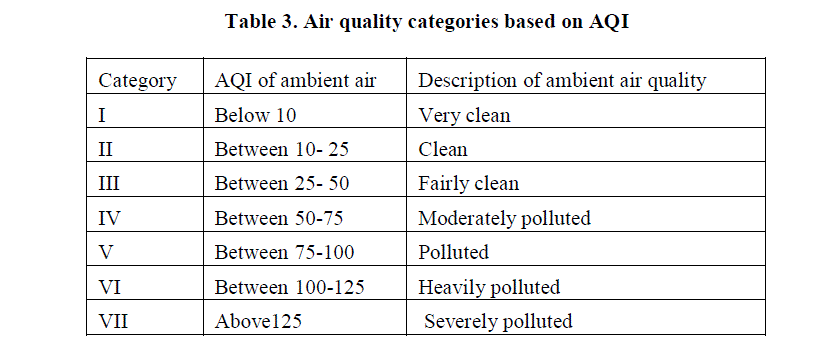ISSN ONLINE(2319-8753)PRINT(2347-6710)
ISSN ONLINE(2319-8753)PRINT(2347-6710)
B.Abraham Lingan1, G. Poyyamoli2 and U.Jagadeesh Chandira Boss3
|
| Related article at Pubmed, Scholar Google |
Visit for more related articles at International Journal of Innovative Research in Science, Engineering and Technology
The generation of municipal solid waste (MSW) in Indian cities has resulted in severe environmental and health problems due to improper management. Air Pollution is one of the major environmental concerns in India due open disposal and burning of MSW. In the present study, suspended particulate matter (SPM), respirable suspended particulate matter (RSPM), sulphur dioxide (SO2 ), oxides of nitrogen(NOX) and carbon monoxide (CO) were investigated in four sites around Kammiampet open dumping ground and a control site in Cuddalore, India. The result was indicated that the concentration of SPM and RSPM in all the study area were higher than NAAQS (CPCB, 2009) and there is an urgent need to regulate and monitor the ambient air quality in Cuddalore, especially around the dumping sites. The Air Quality Index (AQI) calculated for all study sites shows that moderately polluted which is a cause of acute health impacts to the habitants.
Keywords |
| Air pollutants, Ambient Air, Municipal Solid Waste, Dumping Site, Impact, Environment, Human Health. |
INTRODUCTION |
| The problem of municipal solid waste management (MSWM) has become a global challenge from a local/regional/national issue, due to the rapid population growth, urbanization and industrialization. The problem has acquired an alarming dimension and increasing day by day especially in the developing countries during the last few decades which results into a direct threat to the environmental and public health [1]. MSWM is one of the major challenging issues in urban cities, the generation of huge quantities of solid waste culminates in a serious environmental pollution problem, threats to human health, which is a hindrance to the sustainable development of the urban areas [2,3]. Inadequate management of MSW in most cities of developing countries leads to problems that impair human and animal health and ultimately result in economic, environmental and biological losses [3]. The present carried out ambient air quality assessment around Kammiyampet open lendfill site in Cuddalore. |
STUDY AREA DESCRIPTION |
| Cuddalore town is the headquarters of the Cuddalore taluk and the Cuddalore district. It is located at the estuary of rivers Gadilam and Pennayar on Bay of Bengal. The town is at a distance of 200 Kms from south of Chennai, 23 Km south of Puducherry and 45 Kms north of Chidambaram. The latitude and longitude are 11.75°N and 79.75°E respectively. As per 2011 censes the town had population of 173,361 and floating Population of about 20,000. The Cuddalore town covers a total area of 27.69 km2 and is divided in to 8 sanitary division and 45 political wards. The urbanization and industrialization has made rapid changes and expanding residential areas. The lack of adequate collection and treatment of MSW by Cuddalore Municipality Corporation (CMC) has created greater challenges for waste management in the rapidly expanding town. |
METHODOLOGY |
| The present study was conducted to around Kammiyampet dumping area during 2010-2011. In order to understand ambient air quality status around dumping ground, 4 ambient air samples (Table.1) were taken in the vicinity of Kammiyampet dumping ground. The parameters were assessed including suspended particulate matter (SPM), respirable particulate matter (RSPM), sulphur dioxide (SO2) and nitrogen oxides (NOx). |
 |
| For SPM and RPM analysis, the high volume air sampler (HVAS) 1700 (Zenith Eng.) was used. The concentration was measured using quantitative analysis with glass fiber filter paper (Whatman GF/A) PM10 range – 100 to 0.1 μg. The SO2 (sulphur dioxide) concentration was measured using iodine as absorbent and titrated with sodium thiosulphate, indicator-starch, and the NOx (oxides of nitrogen) concentration was measured as follows. Nitrite ion produced during sampling was determined colorimetrically (DR-2000), with a range of 20–740 μg/m³. |
AIR QUALITY INDEX (AQI) |
| The Air Quality Index (AQI) was defined as a scheme to transforms the values of individual air pollutant into single number. AQI was calculated using the method suggested by Tiwari and Ali [4] and improved by Kaushik et al., [5]. The concentration of each pollutant was used to calculate the following formula: |
 |
 |
RESULT AND DISCUSSION |
| Air pollution is a major threat to human health and environment, especially pollution from unscientific disposal sites creates acute health problems to the surroundings habitants [6]. The continues inhalation of particulate matters consists of dust, fumes, mist and smoke cause lung damage and respiratory problems [7]. In this study, the concentration of pollutants like SPM, RSPM, SO2, NOx and CO was carried out in four selected sites around Kammiyampet landfill (Fig.1) and a control site. |
SPM Scenario |
| The SPM concentrations were found to be exceeding at all locations in both the season except the control site (Table.2) At Kammiyampet area, the highest concentrations of SPM were found to be 474.7μg/m³ in pre monsoon (May) and 429.4μg/m³ in post monsoon (November) season, whereas in control site the lowest level of SPM was found to range from 198.5 and 156.6 μg/m³ respectively by pre and post monsoon seasons respectively. Except control site, the level of SPM had exceeded in all other sites than the recommended standard by NAAQS. The SPM values in both seasons were in decreasing order from Kammiyampet > Navanitha Nagar > Meenakshi Nagar > Gadillam Nagar. |
 |
RSPM Scenario |
| The concentrations of RSPM in the study area ranged from 134.3-198.4 μg/m³ in pre monsoon and 117.5- 112.8μg/m³ in the post monsoon. The highest concentration was observed at Kammiyampet sample site in 134.3- 117.5 μg/m³ respectably by pre and post monsoon season, whereas the lowest concentration was found in control site ranging between 76-58.5 μg/m³ in pre and post monsoon seasons respectively. The concentration level of RSPM has exceeded at all the study sites except control site than the recommended standard (100μg/m³) by NAAQS. The RSPM values in both seasons were in decreasing order from Kammiyampet > Navanitha Nagar > Meenakshi Nagar > Gadillam Nagar. |
Gaseous pollutants |
| The measured concentrations of gaseous pollutants such as SO2, NOx and CO around the landfill are comparatively low in both the seasons compared with the recommended standard by NAAQS. The highest SO2 concentrations were observed at Kammiyampet sample site on 21.51μg/m³ in pre monsoon and 19.16μg/m³ in post monsoon season. The NOx levels ranged from 21.5-32.58μg/m³ and 30.34-10.54μg/m³ respectively by pre and post monsoon seasons. The highest level NOx was observed at Kammiampet sample site that ranged from 32.58-30.34μg/m³ in pre and post monsoon seasons. In the present study, the concentrations of SO2, NOx and CO were found to be below permissible limit (80μg/m³ for SO2/NOx and 02μg/m³/CO) as recommended by NAAQS [8] in all the sites for both the seasons. |
 |
Health risk |
| At elevated levels, all the air pollutants will have adverse effects on human and environment. The accumulation of pollutants in the human body through inhalation of air is an important route [9]. The results of the present study revealed higher levels of SPM and RSPM. The dust released from various sources can produce a spectrum of diseases ranging from a simple cold to deadly diseases like cancer as reported by Bency et al [10]. The higher concentration of particulate matter causes acute and chronic respiratory disorders and lung damage in humans [11]. Population residing in the vicinity of polluted region by high suspended particulate matter was reported to have a higher risk of cardiovascular diseases [12]. The high amount of RSPM are either in polluted or moderately polluted category and might be due to the harmful effect of the RSPM dwelling in the area[9]. |
Air quality index (AQI) |
| The Air Quality Index is developed to provide the information about air quality, which is an indicator or determine of some circumstance or property [13]. The observed concentration of air pollutants was calculated into the AQI using by standard formulae which was presented in Table.2 and Table 3 shows the categories of AQI. |
| It was found that the entire study site was ranked as moderately polluted except control site in pre monsoon season. The study sites such as Kammiyampet, Navanitha Nagar and Gadillam Nagar were remain found to be as moderately polluted status in post monsoon season, and rest of study area including Meenakshi Nagar and control site respectively were ranked as fairly clean and clean. |
 |
CONCLUSION |
| The study reveals that the high concentration particulate matter and other pollutants were observed higher level in pre monsoon season compare post monsoon season. The reason is due to the calm or light winds velocity during the pre monsoon season [14]. The concentration of SPM and RSPM are found to be major air pollutants in all area except control site in Cuddalore. The gaseous pollutants like SO2, NOx and CO has considerably low. The particulate matters pose health risks either alone, or in combination with other pollutants [13]. Hence, the high concentration of SPM and RSPM are the most important concern of habitants who living surrounding of dumping site and there is an urgent need to regulate and monitor the ambient air quality in Cuddalore, especially around the dumping sites. |
References |
|